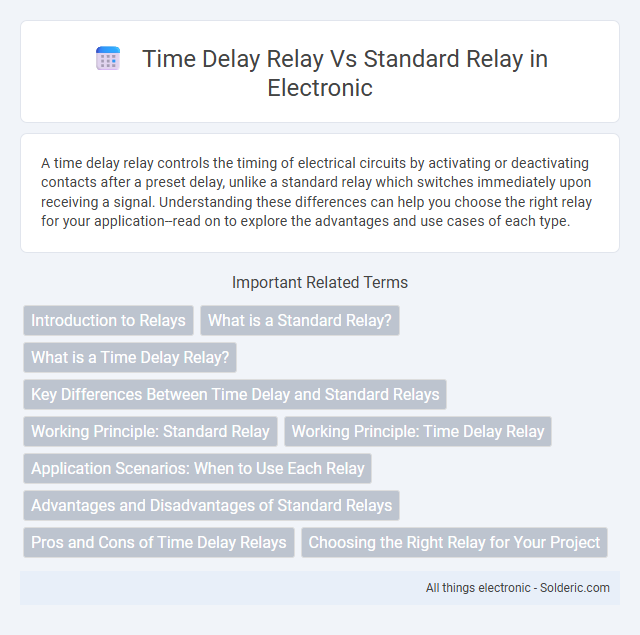A time delay relay controls the timing of electrical circuits by activating or deactivating contacts after a preset delay, unlike a standard relay which switches immediately upon receiving a signal. Understanding these differences can help you choose the right relay for your application--read on to explore the advantages and use cases of each type.
Comparison Table
| Feature | Time Delay Relay | Standard Relay |
|---|---|---|
| Function | Delays switching operation by preset time | Immediate switching operation upon activation |
| Timing Control | Adjustable delay time (milliseconds to hours) | No timing function |
| Applications | Automation, motor control, lighting delay, sequential operations | General switching in circuits |
| Complexity | More complex with integrated timing mechanism | Simple electromechanical or solid-state design |
| Cost | Generally higher due to added features | Lower cost |
| Types | On-delay, off-delay, interval timer | Electromechanical, solid-state relays |
Introduction to Relays
Time delay relays differ from standard relays by incorporating a built-in timing mechanism that controls the relay's activation or deactivation after a preset delay. Standard relays operate by instantly switching electrical circuits on or off based on input signals without any intentional delay. The inclusion of timed control in time delay relays enhances applications requiring precise sequential operations or safety interlocks in industrial automation and control systems.
What is a Standard Relay?
A standard relay is an electromechanical switch used to control a high-power circuit with a low-power signal by opening or closing contacts instantly when energized. Unlike time delay relays, it does not incorporate a preset delay, making it ideal for applications requiring immediate switching. Your choice between standard and time delay relay depends on whether instantaneous activation or controlled timing is critical for the device's operation.
What is a Time Delay Relay?
A Time Delay Relay is an electromechanical or solid-state device designed to delay the activation or deactivation of a circuit for a predetermined period. Unlike a standard relay that operates immediately when energized, a Time Delay Relay introduces a customizable interval, enhancing control in applications such as motor startups, lighting control, and automation systems. Your choice of a Time Delay Relay provides precise timing functions critical for processes requiring sequential operation or protection against rapid cycling.
Key Differences Between Time Delay and Standard Relays
Time delay relays incorporate adjustable timing functions to control the activation or deactivation of circuits after a preset interval, unlike standard relays which operate instantaneously upon receiving an input signal. The key difference lies in the ability of time delay relays to provide precise control over timing sequences in automation and protection systems, enhancing process accuracy and equipment safety. Standard relays are mainly used for simple switching applications without timing control, making time delay relays essential for tasks requiring delayed responses or staggered operations.
Working Principle: Standard Relay
A standard relay operates by using an electromagnet to mechanically switch contacts on or off, allowing current to flow through a different circuit without direct connection. When voltage is applied to the relay coil, it creates a magnetic field that pulls the internal switch, closing or opening the contacts instantaneously. Your system benefits from this fast and reliable switching mechanism, which is ideal for simple on/off control without timing delays.
Working Principle: Time Delay Relay
Time delay relays operate by introducing a preset delay between the activation signal and the switching of contacts, controlled by internal timers such as electromechanical, electronic, or digital circuits. This precise timing function allows devices to perform operations only after a specific interval, improving process control and reducing equipment wear. Your system benefits from enhanced automation and protection by using time delay relays instead of standard relays, which switch contacts immediately upon receiving a signal.
Application Scenarios: When to Use Each Relay
Time delay relays are ideal for applications requiring controlled delays in circuit activation or deactivation, such as motor start sequencing, lighting control, and industrial automation processes to prevent mechanical or electrical overloads. Standard relays are suited for simple switching tasks needing immediate response, commonly used in basic on/off control circuits, signal switching, and protection systems without timing requirements. Choosing between them depends on whether timing precision or instantaneous operation is critical for the specific application scenario.
Advantages and Disadvantages of Standard Relays
Standard relays offer advantages such as simpler design, faster response times, and lower cost compared to time delay relays. They provide reliable switching for immediate circuit control but lack the built-in timing functions necessary for delayed operations. The main disadvantage is their inability to handle time-dependent control tasks, which makes them unsuitable for applications requiring precise timing intervals or delay functions.
Pros and Cons of Time Delay Relays
Time delay relays offer precise control over the activation and deactivation timing of electrical circuits, reducing wear on mechanical components and preventing immediate power surges. They are ideal for applications requiring controlled sequential operations but can be more expensive and complex compared to standard relays. However, their reliance on timing mechanisms may introduce latency in response, potentially limiting their use in scenarios demanding instant switching.
Choosing the Right Relay for Your Project
Selecting a time delay relay or a standard relay depends on the specific timing and control requirements of your project. Time delay relays provide precise control over energizing and de-energizing circuits after a set period, ideal for applications needing delayed operations or sequential control. Standard relays are suitable for simple on/off switching tasks without timing constraints, offering straightforward and reliable circuit control.
Time delay relay vs standard relay Infographic

 solderic.com
solderic.com